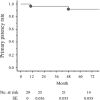Surgical treatment for popliteal artery entrapment syndrome
- PMID: 24719659
- PMCID: PMC3968412
- DOI: 10.3400/avd.oa.13-00081
Surgical treatment for popliteal artery entrapment syndrome
Abstract
Objective: To evaluate the long-term outcomes of surgical treatment for popliteal artery entrapment syndrome (PAES).
Materials and methods: This study was undertaken from a retrospective review of case notes of patients treated for PAES between August 1974 and July 2013. We examined patients' characteristics and surgical procedures, and evaluated long-term outcomes including clinical symptoms and graft or native artery patency.
Results: Twenty-nine limbs (24 patients, mean age: 32 years) underwent surgery. Popliteal arteries were occluded (n = 18) stenosed (n = 7) and normal (n = 4). Twenty-five limbs required both revasularization (interposition [n = 24] and bypass surgery [n = 1]) and myotomy. Four limbs were treated solely with myotomy. During the long-term follow-up period, three limbs required reoperation. The overall primary graft and native popliteal artery patency rates at one and 5 years were 96.3% and 91.9%, respectively.
Conclusion: The treatment of PAES with myotomy and selective revascularization achieves good short- and long-term outcomes. The use of an interposition vein graft reconstruction is associated with minimal morbidity and good long-term patency.
Keywords: autogenous vein graft; intermittent claudication; medial head of the gastrocnemius muscle; popliteal artery entrapment syndrome.
Figures
References
-
- Molinaro V, Pagilasso E, Varetto G, et al. Popliteal artery entrapment syndrome in a young girl: case report of a rare finding. Ann Vasc Surg 2012; 26: 572.e5-9 - PubMed
-
- Collins PS, McDonald PT, Lim RC. Popliteal artery entrapment: an evolving syndrome. J Vasc Surg 1989; 10: 484-9; discussion 489-90 - PubMed
-
- Iwai T, Konno S, Soga K, et al. Diagnostic and pathological considerations in the popliteal artery entrapment syndrome. J Cardiovasc Surg (Torino) 1983; 24: 243-9 - PubMed
-
- López Garcia D, Arranz MA, Tagarro S, et al. Bilateral popliteal aneurysm as a result of vascular type IV entrapment in a young patient: a report of an exceptional case. J Vasc Surg 2007; 46: 1047-50 - PubMed
LinkOut - more resources
Full Text Sources
Other Literature Sources

